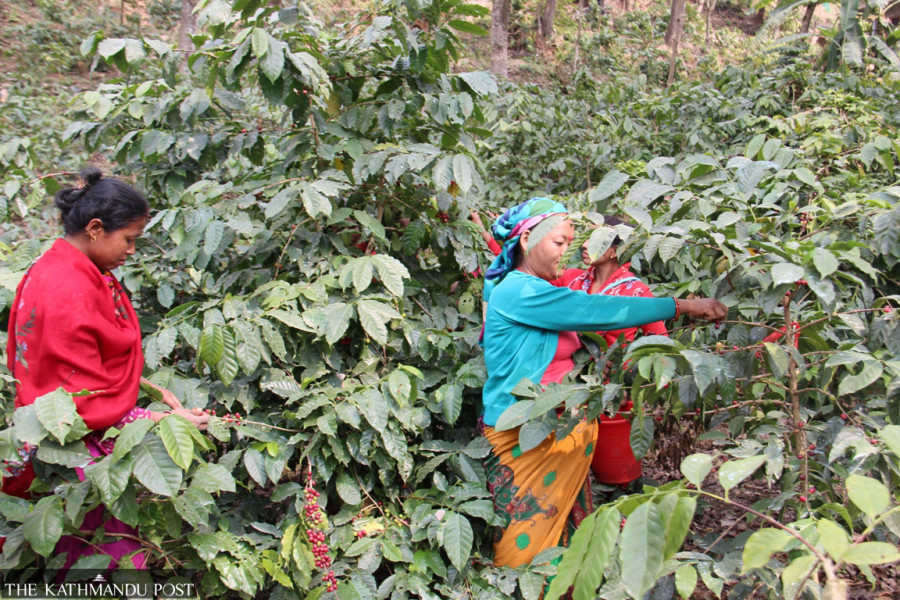Money
Sindhupalchok emerges as coffee heartland
Around 2,150 households in all 12 local units of the district are engaged in coffee farming, say officials.
Anish Tiwari
Chudamani Poudel of Ukhubaari, Sunkoshi Rural Municipality-3 had planted nearly a thousand coffee saplings on his farm in 2015.
Now the plants yield around a tonne of red cherry coffee beans each year, earning him Rs500,000.
Yam Bahadur Mahat of Chautara has 600 trees and earns Rs200,000 annually selling coffee beans.
“Although coffee trees require more maintenance, they give better returns than other crops,” said Mahat.
Coffee farmer Bed Prasad Poudel of Barhabise who owns 500 trees agrees with Mahat.
According to the District Coffee Cooperatives Association Sindhupalchok, around 2,150 households in all 12 local bodies of the district are engaged in commercial coffee farming.
These farms have a combined coffee acreage of more than 124 hectares.
The association has 12 cooperatives and 18 farmers' groups in the district among its members, and it has taken the responsibility of processing and marketing the coffee produced by the farmers.
The coffee grown in the district has been branded by the association as Sindhu Organic Coffee. The price of green beans is $9 per kg in the international market. In Kathmandu and elsewhere in the country, it costs around Rs100 per kg.
Manju Khadka, president of the District Coffee Cooperatives Association Sindhupalchok, says the farmers in the district grow more than 31 tonnes of coffee annually and earn around Rs20 million.
“The major market for locally produced coffee is Kathmandu. Increasing exports to foreign countries is attracting more farmers towards commercial coffee farming,” said Khadka.
“Demand for our organic coffee has been rising in South Korea, Japan and Australia. Each year, we export around 7 tonnes of coffee, and this year we have shipped more than 7.5 tonnes.”
Companies like Beautiful Coffee Korea in South Korea, Himalayan Organic Coffee in Australia and Coffee of Nepal in Japan are the major buyers of Sindhu Organic Coffee.
“Each farmer gets an equal share of Rs10 per kg from the profits,” said Khadka.
According to the National Tea and Coffee Development Board, coffee is grown in 40 districts in the mid-hills at altitudes of 1,000 to 1,600 metres.
Gulmi, Palpa, Arghakhanchi, Lalitpur, Tanahu, Kabhre, Sindhupalchok, Lamjung, Kaski, Gorkha, Syangja, Parbat and Baglung have a great potential for organic coffee production because they have the right topography, soil, relative humidity, temperature and rainfall for coffee farming.
The National Tea and Coffee Development Board says that coffee cultivation is still a relatively new concept in Nepal.
Coffee was first grown in Aapchaur of Gulmi district in 1938 by a hermit named Hira Giri who had brought some coffee seeds from Sindu province of Myanmar (then Burma).
Until the 1970s, coffee was overlooked as an unusual crop. The plant travelled from farmer to farmer for almost four decades as a curiosity.
The government of Nepal bought coffee seeds from India for distribution in the late 1970s, which helped to expand coffee as a commercial crop to some extent.
Midway through the 1980s, a significant move toward commercial coffee production occurred. Nepal Coffee Company, founded in Manigram, Rupandehi district in 1983-84, procured coffee cherries from the growers and processed coffee for the domestic market.
Because of an uncertain market, coffee producers were unsure about the crop's potential as a source of revenue until the beginning of 2000. After 2002, a significant rise in exports and an increment in domestic demand led some coffee producers to view coffee as a key crop for generating income.




 9.88°C Kathmandu
9.88°C Kathmandu














